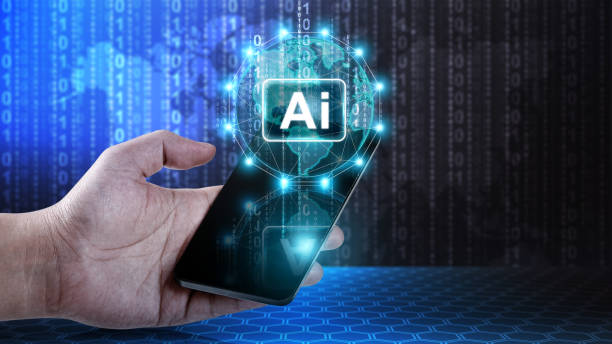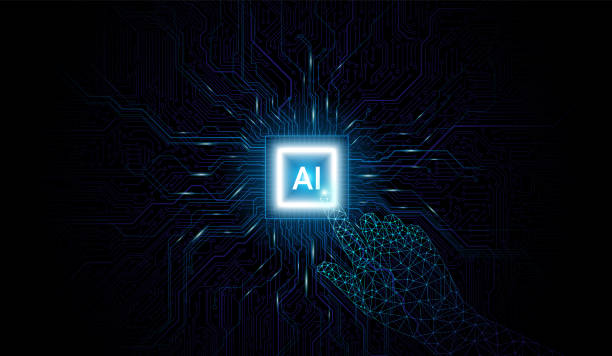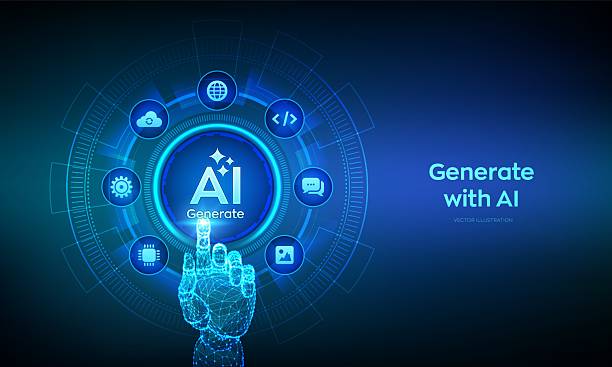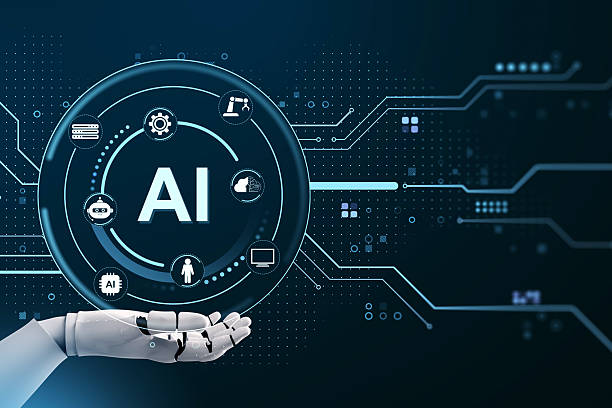### What is Artificial Intelligence? Definition and Basic Concepts
Artificial intelligence (#artificial_intelligence) is a branch of computer science that deals with building machines capable of performing tasks that typically require human intelligence.
These tasks include learning, reasoning, problem-solving, language understanding, and pattern recognition.
In other words, the goal of artificial intelligence is to create systems that can think, learn, and act.
To better understand artificial intelligence, it is necessary to be familiar with its basic concepts.
Definition of Artificial Intelligence Artificial intelligence does not have a single definition, but generally refers to the ability of a system to perform tasks that require human intelligence.
This definition includes the ability to learn from data, logical reasoning, solving complex problems, and understanding natural language.
Basic Concepts
- Machine Learning: One of the most important subfields of artificial intelligence that allows machines to learn from data without explicit programming.
- Neural Networks: Computational models inspired by the structure of the human brain and used for pattern recognition and deep learning.
- Natural Language Processing: The ability of machines to understand, interpret, and generate human language.
- Computer Vision: The ability of machines to understand and interpret images and videos.
- Robotics: The design, construction, and operation of robots to perform automated tasks.
Artificial intelligence is currently used in many industries and fields, and with increasing advancements, it will play a more important role in our lives.
For more information, you can visit the Artificial Intelligence page on Wikipedia.
Are you tired of losing business opportunities due to not having a professional company website? Don’t worry anymore! With Rasaweb’s corporate website design services:
✅ Your brand’s credibility and professionalism will increase.
✅ You will attract more customers and sales leads.
⚡ Get a free consultation to get started now!
Types of Artificial Intelligence from Expert Systems to Deep Learning
Artificial intelligence is generally divided into two main categories: #Weak_AI (Narrow AI) and Strong AI (General AI).
Weak AI is designed to perform specific tasks and performs very well in that area.
Examples of weak AI include facial recognition systems, voice assistants such as Alexa and Siri, and product recommendation systems.
This type of artificial intelligence is currently very common and is used in various industries.
Click here to preview your posts with PRO themes ››
Strong AI, on the other hand, refers to systems that are capable of performing any task that a human can do.
This type of artificial intelligence is still in the research stages and has not been fully realized.
The goal of developing strong AI is to create machines that can think, learn, and make decisions like humans.
Expert Systems Expert systems were among the first attempts in the field of artificial intelligence that sought to model the knowledge and expertise of a human in a specific field.
These systems typically consist of a knowledge base and an inference engine that solve problems using logical rules.
Machine Learning Machine learning is a newer approach in artificial intelligence that allows machines to learn from data without being explicitly programmed.
This approach includes various algorithms such as regression, classification, and clustering.
Deep Learning Deep learning is a subset of machine learning that uses deep neural networks to learn complex patterns in data.
This approach has performed very well in areas such as image recognition, natural language processing, and voice recognition.
Artificial intelligence is evolving, and with increasing advancements, new types of intelligent systems are emerging.
For more information, you can visit this article.
Applications of Artificial Intelligence in Daily Life and Various Industries
Artificial intelligence (#artificial_intelligence) is widely used in daily life and various industries.
Common applications include:
- Healthcare: Disease diagnosis, drug development, robotic surgery, and medical data management.
- Transportation: Self-driving cars, route optimization, and traffic management.
- Finance: Fraud detection, risk management, and financial advice.
- Manufacturing: Automation of production lines, quality control, and prediction of equipment failures.
- Education: Personalizing education, providing automatic feedback, and developing educational content.
- Marketing: Analyzing customer behavior, targeted advertising, and personalized offers.
Artificial intelligence is reshaping various industries, helping companies become more competitive by improving efficiency and reducing costs.
For example, in the healthcare industry, artificial intelligence can help doctors diagnose diseases more accurately, resulting in improved patient care.
In the manufacturing industry, artificial intelligence can help companies optimize their production lines and reduce production costs.
Click here to preview your posts with PRO themes ››
Below is a table showing some of the key applications of artificial intelligence in various industries:
| Industry | Application |
|---|---|
| Healthcare | Disease diagnosis, drug development |
| Transportation | Self-driving cars, traffic management |
| Finance | Fraud detection, risk management |
| Manufacturing | Automation, quality control |
Artificial intelligence has a high potential to improve our lives and reshape the world.
For more information, you can visit this link.
Challenges and Limitations of Artificial Intelligence
Artificial intelligence (#artificial_intelligence), despite its many potentials, also faces challenges and limitations.
One of the main challenges is the need for large and high-quality data to train machine learning models.
If the data is incomplete, inaccurate, or biased, artificial intelligence models will also provide inaccurate results.
In addition, the interpretability of deep learning models is also a major challenge.
In many cases, it is not possible to accurately understand why a model made a particular decision, which can be problematic in some applications, such as medical diagnosis.
Ethical issues are also a major challenge for artificial intelligence.
For example, the use of artificial intelligence in judicial and legal systems can lead to racial and gender discrimination if the training data contains discriminatory patterns.
Also, the use of artificial intelligence in automated weapons can lead to wars without human intervention, which is ethically very controversial.
Privacy is also a major concern regarding artificial intelligence.
Many artificial intelligence systems need to collect and analyze personal data to function properly, which can lead to a violation of people’s privacy.
For example, facial recognition systems can be used to track people without their knowledge.
Security is another major challenge for artificial intelligence.
Machine learning models can be vulnerable to cyber attacks, and hackers can mislead models by manipulating training data.
This can be very dangerous in sensitive applications such as self-driving cars and security systems.
For more information, you can visit this article.
Does your current website reflect your brand’s credibility as it should? Or does it drive away potential customers?
Rasaweb, with years of experience in designing professional corporate websites, is your comprehensive solution.
✅ A modern, beautiful website that matches your brand identity
✅ Significant increase in lead generation and new customers
⚡ Contact Rasaweb now to get a free corporate website design consultation!
The Future of Artificial Intelligence and Its Impact on Society
The future of artificial intelligence (#artificial_intelligence) looks very bright.
With increasing advancements in this field, artificial intelligence is expected to play a more important role in our lives.
In the future, we may see more advanced self-driving cars, smarter healthcare systems, and versatile home robots.
Artificial intelligence has the potential to improve many aspects of our lives and help solve complex global issues.
However, the impact of artificial intelligence on society can be both positive and negative.
On the one hand, artificial intelligence can help create new jobs and increase economic productivity.
On the other hand, artificial intelligence can lead to the loss of some jobs and exacerbate economic inequality.
Therefore, it is necessary for governments and organizations to adopt policies that benefit from the advantages of artificial intelligence and prevent its risks.
Education and awareness also play an important role in shaping the future of artificial intelligence.
It is necessary for people to be educated about artificial intelligence and its applications so that they can use this technology responsibly and consciously.
Also, it is necessary to discuss and debate ethical and social issues related to artificial intelligence so that we can make the right decisions about the development and use of this technology.
Artificial intelligence is a powerful technology that has a high potential to improve our lives and reshape the world.
However, it is necessary to develop this technology carefully and responsibly to benefit from its advantages and prevent its risks.
For more information, you can visit this link.
How Machine Learning Works: A Step-by-Step Guide
Machine learning, a subset of artificial intelligence (#artificial_intelligence), allows machines to learn from data without explicit programming.
This process involves different steps, which we will explain below:
- Data Collection: The first step in machine learning is to collect data related to the problem at hand.
This data can include images, text, audio, financial data, or any other type of data. - Data Preparation: After collecting the data, it is necessary to prepare it for training the machine learning model.
This process includes cleaning the data, converting the data to the appropriate format, and dividing the data into two sets: training and testing. - Model Selection: After preparing the data, we must select a suitable machine learning model for the problem at hand.
There are different models for machine learning, including linear regression, logistic regression, decision trees, support vector machines, and neural networks. - Model Training: After selecting the model, we must train it using the training data.
In this step, the model tries to learn the patterns in the data and adjust its parameters to make accurate predictions. - Model Evaluation: After training the model, we must evaluate it using the test data.
In this step, we examine the performance of the model on data it has not seen before and measure its accuracy and efficiency. - Model Optimization: If the model’s performance is not acceptable, we can optimize it using different techniques.
These techniques include adjusting the model parameters, using more advanced optimization algorithms, or collecting more data.
Machine learning is an iterative process that involves trial and error.
To reach a well-performing machine learning model, it is necessary to repeat the above steps several times and use different techniques.
For more information, you can visit this link.
Deep Neural Networks: Architecture and Applications
Deep Neural Networks are a type of machine learning model that is inspired by the structure of the human brain.
These networks consist of multiple layers of interconnected nodes, also called neurons.
Each neuron applies a simple mathematical function to its input and passes the result to the neurons in the next layer.
The architecture of deep neural networks is designed to learn complex patterns in data.
The initial layers of the network learn simpler patterns, while the later layers learn more complex patterns.
This feature makes deep neural networks very suitable for solving complex problems such as image recognition, natural language processing, and speech recognition.
Deep neural networks are currently used in many industries and fields.
For example, in the healthcare industry, deep neural networks are used to diagnose diseases and develop drugs.
In the transportation industry, deep neural networks are used to build self-driving cars.
In the financial industry, deep neural networks are used to detect fraud and manage risk.
Below is a sample table of types of deep neural networks and their applications:
| Deep Neural Network Type | Application |
|---|---|
| Convolutional Neural Networks (CNN) | Image Recognition, Video Recognition |
| Recurrent Neural Networks (RNN) | Natural Language Processing, Speech Recognition |
| Generative Adversarial Networks (GAN) | Image Generation, Text Generation |
Artificial intelligence (#artificial_intelligence) is able to solve more complex problems and achieve significant advancements in various fields using deep neural networks.
For more information, you can visit this link.
How Natural Language Processing: How Computers Understand Human Language
Natural Language Processing (NLP) is a branch of artificial intelligence (#artificial_intelligence) that allows computers to understand, interpret, and generate human language.
This process includes different steps, which we will explain below:
- Tokenization: The first step in natural language processing is tokenization.
In this step, the input text is divided into smaller tokens, such as words and punctuation marks. - Stemming: After tokenization, it is necessary to find the root of the words.
Stemming means converting words to their base form.
For example, the root of the word “I go” is the word “to go.” - Part-of-Speech Tagging: In this step, the role of each word in the sentence is determined.
For example, it is specified whether a word is a noun, verb, adjective, or adverb. - Syntactic Parsing: After part-of-speech tagging, it is necessary to parse the syntactic structure of the sentence.
Syntactic parsing means determining the relationships between words in the sentence. - Semantic Analysis: After syntactic parsing, it is necessary to analyze the meaning of the sentence.
Semantic analysis means understanding the overall meaning of the sentence.
Natural language processing is currently used in many applications.
For example, natural language processing is used in machine translation systems, chatbots, information retrieval systems, and text summarization systems.
For more information, you can visit this link.
Are you unhappy with the low conversion rate of visitors to customers on your online store website?
Solve this problem forever with a professional online store website design by Rasaweb!
✅ Increase the rate of converting visitors into customers
✅ Create an excellent user experience and gain customer trust
⚡ Get a free consultation
Computer Vision: How Computers See the World
Computer Vision is a branch of artificial intelligence (#artificial_intelligence) that allows computers to understand and interpret images and videos.
This process includes different steps, which we will explain below:
- Image Collection: The first step in computer vision is to collect images related to the problem at hand.
These images can be collected from various sources such as cameras, scanners, and image databases. - Image Preprocessing: After collecting the images, it is necessary to prepare them for processing.
This process includes adjusting the image size, converting the images to the appropriate format, and removing noise from the images. - Feature Detection: In this step, important features of the images, such as edges, corners, and textures, are detected.
- Image Classification: After feature detection, it is necessary to classify the images.
Image classification means determining what an image shows.
For example, an image may show a cat, a dog, or a car. - Object Detection: In this step, objects in the images are detected.
Object detection means determining which objects are in an image and where their location is.
Artificial intelligence (#artificial_intelligence) in computer vision is currently used in many applications.
For example, computer vision is used in facial recognition systems, self-driving cars, video surveillance systems, and quality inspection systems.
For more information, you can visit this link.
Is Artificial Intelligence a Threat to Human Jobs?
One of the main concerns about artificial intelligence (#artificial_intelligence) is whether this technology is a threat to human jobs or not.
The answer to this question is complex and depends on various factors.
On the one hand, artificial intelligence can automate many repetitive and tedious tasks that are currently performed by humans.
This can lead to the loss of some jobs, especially jobs that involve performing routine and repetitive tasks.
On the other hand, artificial intelligence can also help create new jobs.
With the advancement of artificial intelligence, the need for specialists who can develop, implement, and maintain this technology will increase.
Also, artificial intelligence can help create new jobs in industries that do not yet exist.
For example, the self-driving car industry can create millions of new jobs.
Artificial intelligence improves productivity and increases efficiency.
Ultimately, the impact of artificial intelligence on human jobs depends on how we manage this technology.
If we adopt policies that support workforce training and retraining and help people learn new skills, we can benefit from the advantages of artificial intelligence and avoid its risks.
Otherwise, we may see increased economic inequality and the loss of many jobs.
For more information, you can visit this link.
FAQ
| Question | Answer |
|---|---|
| 1. What is Artificial Intelligence (AI)? | It is a branch of computer science that aims to create machines capable of simulating human intelligence and performing tasks that require human thinking, such as learning, problem-solving, and decision-making. |
| 2. What are the main types of artificial intelligence? | They can be classified into weak artificial intelligence (Narrow AI) that focuses on a specific task, general artificial intelligence (General AI) that possesses comprehensive human capabilities, and super artificial intelligence (Super AI) that surpasses human intelligence. |
| 3. Mention some common applications of artificial intelligence in our daily lives. | They include voice assistants (such as Siri and Alexa), recommendation systems (such as Netflix and Amazon), self-driving cars, facial recognition systems, and spam filters. |
| 4. What is the difference between Artificial Intelligence and Machine Learning (Machine Learning)? | Artificial intelligence is the broader concept of creating intelligent machines, while machine learning is a subset of artificial intelligence that focuses on enabling systems to learn from data without explicit programming. |
| 5. What is Deep Learning (Deep Learning)? | It is a subset of machine learning that uses multi-layered artificial neural networks (deep neural networks) to process data and discover complex patterns, and is used in image and speech recognition. |
| 6. What are the most prominent benefits of artificial intelligence? | Improving efficiency and productivity, automating repetitive tasks, making better decisions based on analyzing big data, and developing solutions to complex problems in fields such as medicine and science. |
| 7. What are the main challenges facing the development and deployment of artificial intelligence? | They include the need for huge amounts of high-quality data, privacy and security issues, bias in data and algorithms, and high development and maintenance costs. |
| 8. Does artificial intelligence raise ethical or social concerns? | Yes, it raises concerns related to privacy, algorithmic bias, job loss due to automation, and responsibility for errors made by intelligent systems, and the need for a regulatory framework. |
| 9. How can artificial intelligence affect the future of the labor market? | It can lead to the automation of some routine tasks, but it will also create new jobs that require advanced skills in developing, operating, and maintaining artificial intelligence systems. |
| 10. What are some modern or promising technologies in the field of artificial intelligence? | They include advanced Natural Language Processing (NLP) (such as large language models like ChatGPT), Computer Vision, Robotics, and Generative AI. |
And other advertising services of Rasa Web Advertising Agency in the field of advertising
Intelligent Reportage: A new service to increase customer attraction through marketing automation.
Smart Digital Advertising: Professional optimization for managing campaigns using dedicated programming.
Smart Digital Branding: A quick and efficient solution to increase sales by focusing on optimizing key pages.
Smart Marketplace: An effective tool to attract customers with the help of marketing automation.
Smart Customer Journey Map: A quick and efficient solution to increase website visits by focusing on optimizing key pages.
And hundreds of other services in the field of internet advertising, advertising consulting, and organizational solutions
Internet Advertising | Advertising Strategy | Reportage Ad
Resources
Artificial Intelligence (AI): Introduction, Fundamentals, Applications, Future Perspectives
,What is Artificial Intelligence? In Simple Terms (+ Applications and Types)
,What is Artificial Intelligence? – Familiarity with Basic Concepts and Applications of Intelligence …
,Artificial Intelligence (AI): The Ultimate Guide to Understanding AI
? In Rasa Web Afarin, your dream of a powerful presence in the digital world becomes a reality. We take your business to the top by providing comprehensive digital marketing services including fast website design and professional optimization.
📍 Tehran, Mirdamad Street, next to the Central Bank, South Kazerun Alley, Ramin Alley No. 6














